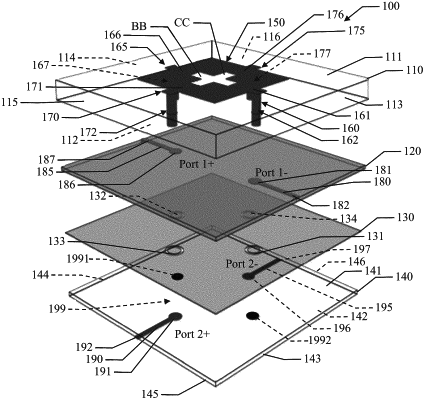| CPC H01Q 9/045 (2013.01) [H01Q 1/48 (2013.01); H01Q 21/065 (2013.01)] | 19 Claims |

|
1. A differentially-fed dual-polarized antenna comprising:
an upper substrate and a lower substrate;
a bonding film bonding the upper substrate to the lower substrate;
a ground plane arranged between the bonding film and the lower substrate;
a parasitic patch arrangement arranged on an upper surface of the upper substrate;
first and second radiator arms arranged on the upper surface of the upper substrate, operably coupled with the parasitic patch arrangement, spaced apart by a first gap, and responsive respectively to complementary components of a first differential signal to emit a first radio frequency signal having a first polarization characteristic;
first and second vias extending from the upper surface of the upper substrate to a lower surface of the upper substrate, the first via connected electrically to a distal end of the first radiator arm distal from the second radiator arm, the second via connected electrically to a distal end of the second radiator arm distal from the first radiator arm;
first and second feed lines arranged on the lower surface of the upper substrate, connected electrically and respectively to the first and second vias, and adapted to respectively receive the complementary components of the first differential signal;
third and fourth radiator arms arranged on the upper surface of the upper substrate, operably coupled with the parasitic patch arrangement, spaced apart by a second gap intersecting the first gap, and responsive respectively to complementary components of a second differential signal to emit a second radio frequency signal having a second polarization characteristic orthogonal to the first polarization characteristic;
third and fourth vias extending from the upper surface of the upper substrate to a lower surface of the lower substrate, the third via connected electrically to a distal end of the third radiator arm distal from the fourth radiator arm, the fourth via connected electrically to a distal end of the fourth radiator arm distal from the third radiator arm, and
third and fourth feed lines arranged on the lower surface of the lower substrate, connected electrically and respectively to the third and fourth vias, and adapted to respectively receive the complementary components of the second differential signal.
|